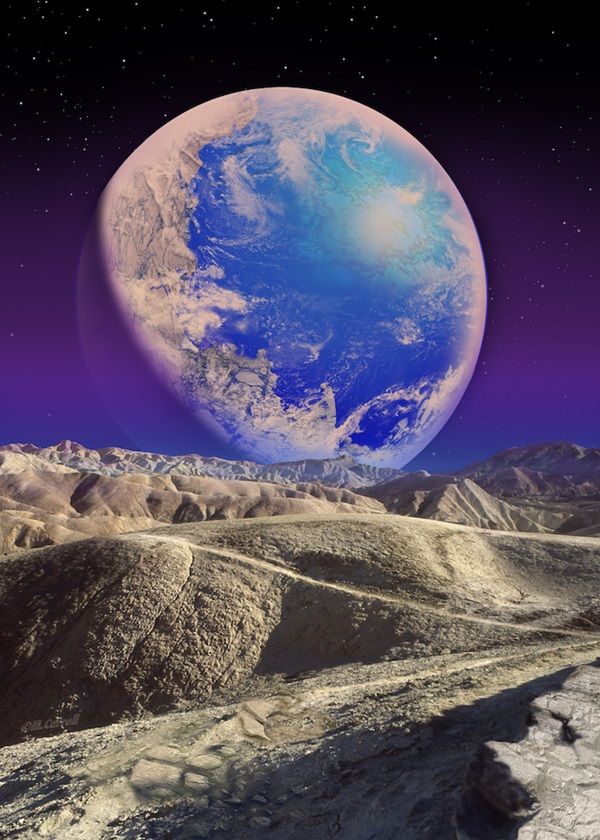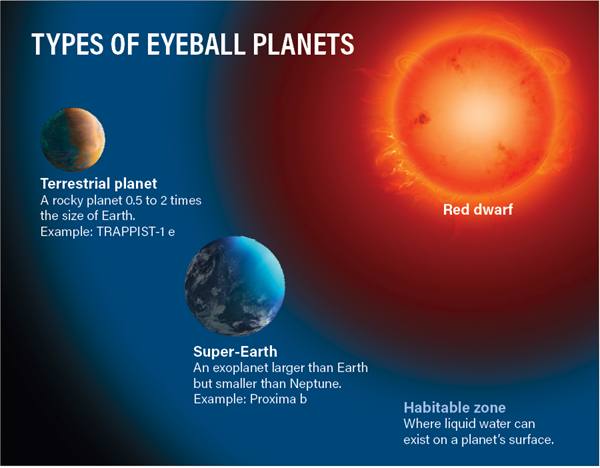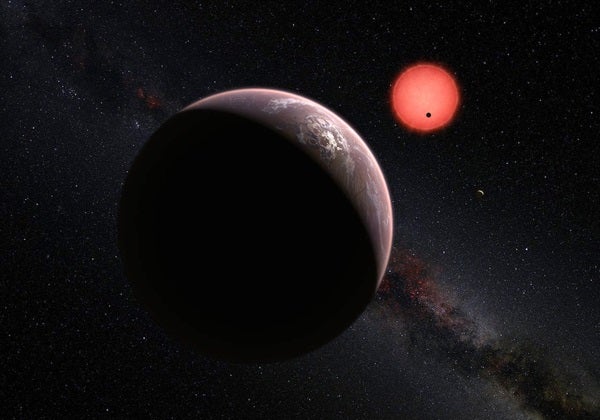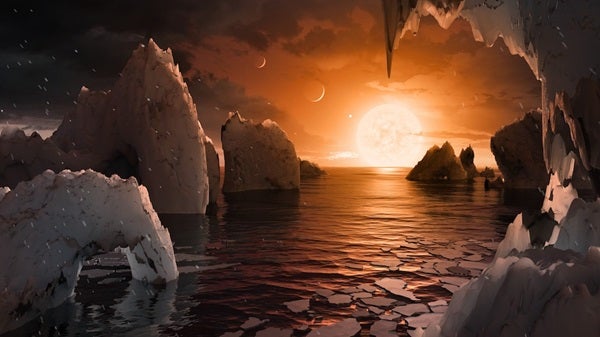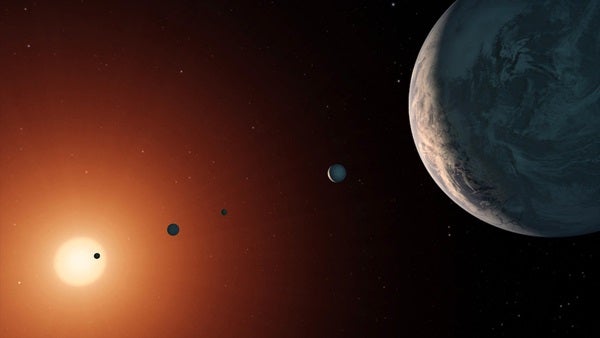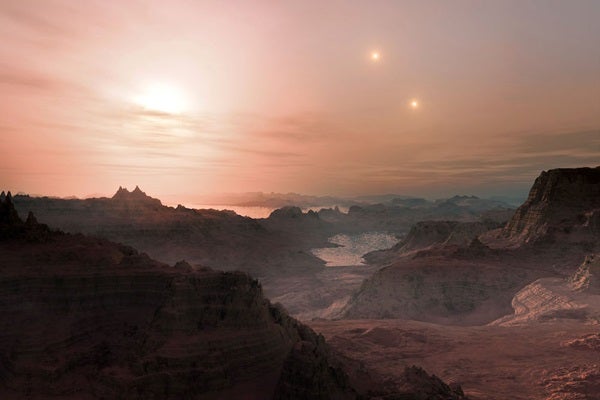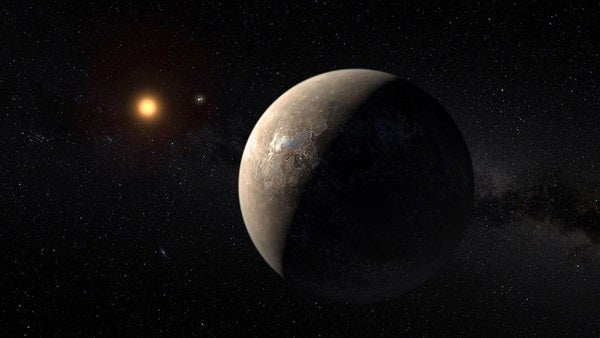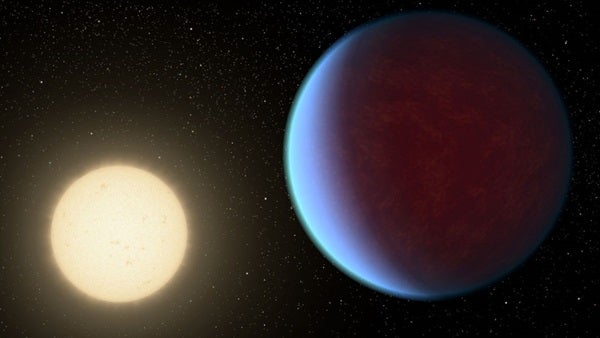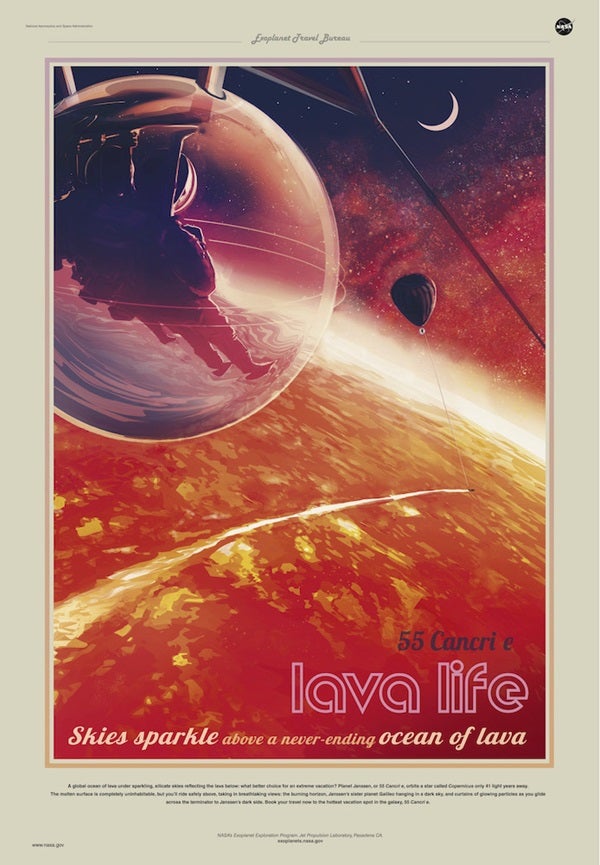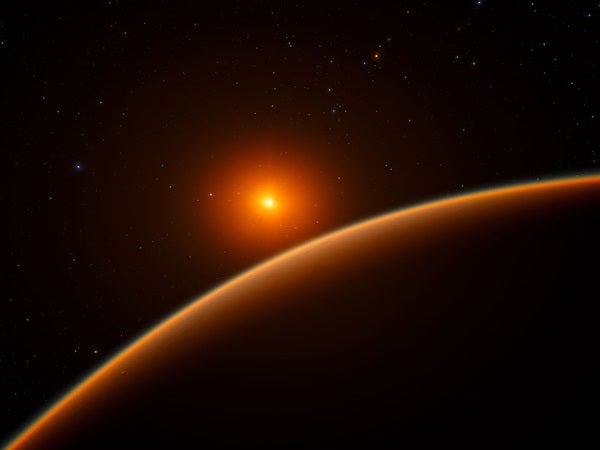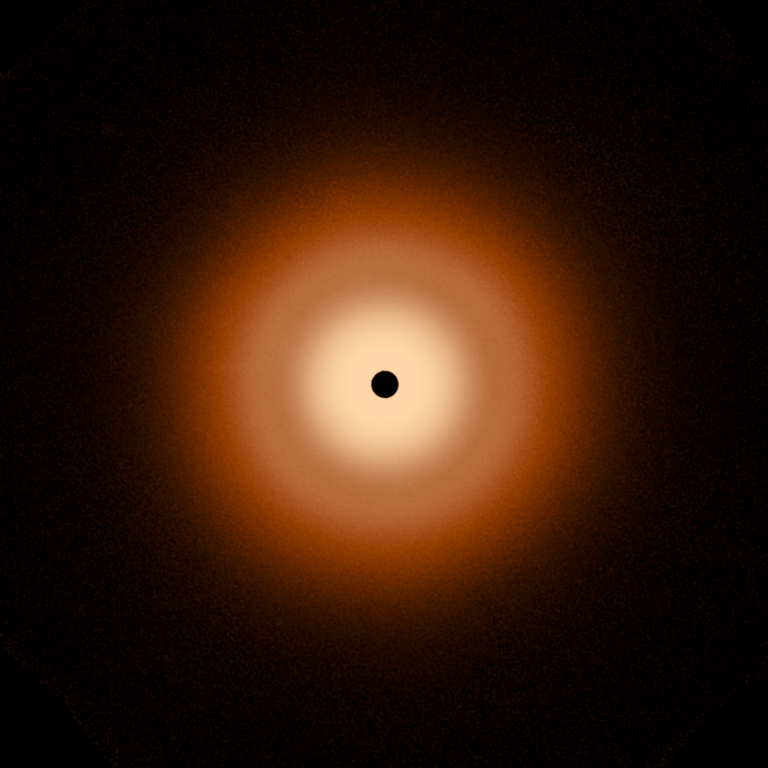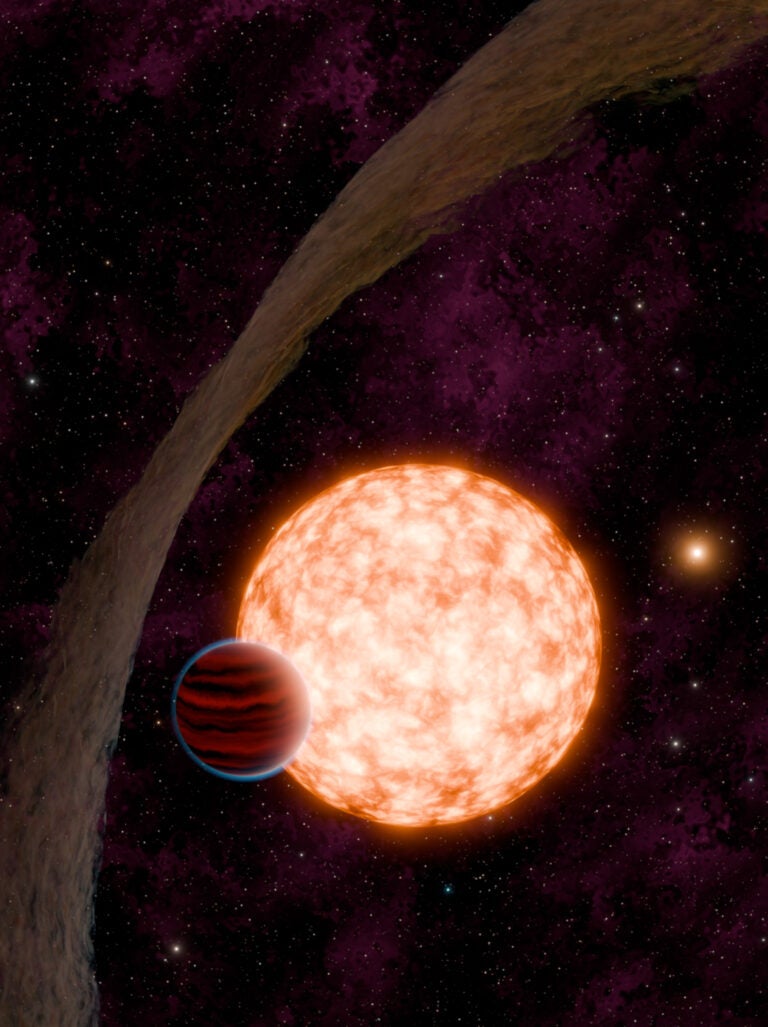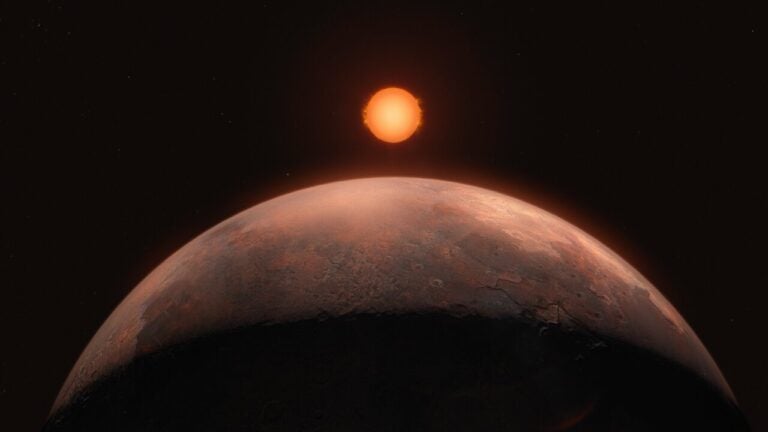Humans have long imagined what life on another world may look like. And as we entered a golden age of exoplanet discovery, the hunt picked up for Earth 2.0, a twin to our planet orbiting within its star’s habitable zone. But so far, searches have turned up empty, leading scientists to use some out-of-the-box thinking to find another haven for life in the universe.
The habitable zone, or Goldilocks zone, is the region surrounding a star where water can exist on the surface of an orbiting planet or moon. The hotter the star, the farther away its habitable zone sits. Take red dwarfs, for example: Of the hundreds of billions of stars in our galaxy, astronomers estimate that about 80 percent of them are red dwarfs. At a mere 0.08 to 0.5 times the mass of the Sun, these stars only reach surface temperatures around 4,000 to 6,700 degrees Fahrenheit (2,200 to 3,700 degrees Celsius). Thus, the habitable zone is quite close to these stars.
That proximity makes it much easier to spot any planets that pass in front of the tiny star, as such eclipses tend to block a large fraction of starlight and make the presence of an exoplanet clear. During its nine-year mission, the planet-hunting Kepler space telescope found 2,709 planets through this transit method; another 2,057 are still awaiting confirmation. And most of Kepler’s finds are worlds circling close to red dwarf suns, some of which are similar in size to our own.
Among these Earth-like exoplanets, there exists a bizarre class known as eyeball planets. These worlds orbit so near to their suns that they are tidally locked, with one hemisphere always facing toward the star and the opposite one in eternal night. Scientists are beginning to realize that eyeball worlds are more than just curiosities — they’re key to understanding how common life might be in the universe. Their arrangement of an always-lit and always-dark side causes fascinating weather and unusual surface conditions. These characteristics may make eyeball planets within the Goldilocks zone prime candidates for hosting life, but they could also make otherwise habitable planets inhospitable.
Oceanic eyes
After coalescing around its star, a planet has some spin. But over time, the host star’s gravity pulls at the world, slowing the body’s rotation until it becomes tidally locked. We have a good example of such synchronous rotation on our own cosmic front porch: The Moon orbits Earth once a month and takes the same amount of time to turn once on its axis. This means that we always see the same face of our Moon.
Eyeball planets initially got their moniker when astronomers noted that in the habitable zone, tidally locked worlds covered by water would become frozen starting at the terminator (the edge of night) while the seas would remain clear near the substellar point (the point that directly faces the star). This dark blue central ocean surrounded by sea ice gives the appearance of an eyeball.
As astronomers racked up exoplanet discoveries over the last 30 years, they realized eyeball planets may be plentiful among planetary systems and that a wide range of worlds may take on an eyeball form. One common example is super-Earths, worlds that are larger than Earth but smaller than Neptune.
Allison Youngblood, an astrophysicist at NASA’s Goddard Space Flight Center in Greenbelt, Maryland, has been using the Hubble Space Telescope to study super-Earths orbiting near red dwarfs. “There’s some evidence of super-Earths with thick atmospheres and some with thin or no atmospheres at all,” but observations point to many of these worlds being “really cloudy and hazy,” she says. This would make spotting life difficult, but some astronomers believe that, in the right scenario, super-Earths hold the most promise for life beyond the solar system.
One such scenario is on eyeball super-Earths. These worlds are likely covered in vast oceans. On the night hemisphere, the planet suffers arctic conditions while the dayside swelters, the heat burning away clouds and, in extreme scenarios, the ocean itself. The habitability of such a planet depends on a lot of factors, including the day/night temperature, the activity of the host star, the density of the planet’s atmosphere, and even the saltiness of the ocean.
As it so happens, a prime target for habitability sits just at our interstellar back door. Proxima b is an eyeball super-Earth orbiting within the habitable zone of Proxima Centauri, the closest star to our solar system. A 2017 study published in Astrobiology modeled potential climates of the exoplanet, assuming a variety of conditions. The researchers concluded that a Proxima b “with an atmosphere similar to modern Earth’s can have a habitable climate with a broad region of open ocean, extending to the nightside.”
How far the ocean extends depends upon the amount of salt assumed in the water, but even with an ocean with high salinity, Proxima b could theoretically host life. One only has to look as far as Earth’s infamous Dead Sea, where life has found a way to thrive despite a salt concentration above 30 percent. So, it isn’t impossible for salt-loving bacteria to likewise exist on Proxima b in this scenario.
TRAPPIST-1 e
Distance from Earth: 41 light-years
Mass: 0.69 Earths
Radius: 0.92 times Earth
Year: 6.1 daysA member of one of the most famous stellar systems, TRAPPIST-1 e is one of seven exoplanets around Trappist-1. Several of the worlds may be eyeball planets. But while all the planets could also have water, only three lie firmly within the star’s habitable zone.
A hot, bright, early stellar phase may have caused all the evolving planets to look like Venus: any early oceans long since evaporated, leaving behind a thick, uninhabitable atmosphere. But according to a 2018 study published in the Astrophysical Journal, Trappist-1 e is the most likely to have managed to retain water, perhaps even hosting an Earth-like ocean.
All seven of the Trappist-1 planets have similar densities, making the system very different from our own. Such similar densities suggest the planets also all have similar compositions. The James Webb Space Telescope will be able to probe further into the atmospheres of these exoplanets, searching for elements that could hint at the presence of life.
Open oceans aren’t the only possible surface conditions for Proxima b. A paper published in Nature Astronomy in 2019 suggests that oceans beneath the substellar point might freeze over because of sea-ice dynamics. Modeling conditions on Proxima b, the researchers found that as sea ice drifts into warmer waters, the ice cools the ocean as it melts. Gradually, more and more of the ocean freezes, even on the dayside. At that point, only an atmosphere with abundant greenhouse gases could prevent global freezeover.
But, according to Eric Wolf, a research associate at the Laboratory for Atmospheric and Space Physics in Boulder, Colorado, other models have shown the opposite scenario. Just as ice can drift from cold regions to warm regions, heated waters can also serve as a transporter of heat from warm regions to cold regions and melt the ice, warming the climate instead. “Depending on the details,” Wolf says, “the climate could very literally be anything from the cold, icy states shown by [the 2019 study] to Venus-like, hot, CO2-dominated worlds, or they could even look like [Saturn’s moon] Titan with [methane] and hazes.” Not to mention that if continents are included in the mix, he adds, “all bets are off because the presence and location of continents significantly changes the patterns of ocean transports.”
So even if an eyeball planet lies within the habitable zone, its surface can range wildly from endless ocean to frozen wasteland.
Rock-solid places
While super-Earth eyeball planets are ocean-covered orbs cocooned in dense atmospheres, smaller Earth-like tidally locked worlds have rockier surfaces. Where the planet’s star blazes overhead, desert conditions blanket the landscape. Closer to the nightside, the environment becomes more clement, perhaps allowing for liquid water within that twilight zone. Also within that twilight region, provided the planet has enough atmosphere with strong wind currents, the surface may remain above freezing. But if the air is thin or stagnant, temperatures will drop precipitously, even if the planet is on the inner edge of its star’s habitable zone.
However, these smaller eyeball planets face a larger problem than temperature in terms of habitability: atmospheric erosion. An atmosphere is crucial for life’s survival, but, orbiting close to their red dwarf suns, these small worlds face ferocious stellar winds that can strip away even the densest of atmospheres. Exoplanet expert Avi Mandell of NASA’s Goddard Space Flight Center points out that “some amount of atmosphere will always be eroded — we’re losing some atmosphere from Earth all the time due to our own Sun.” But, if not replenished quickly enough by gases leaking out from the planet’s interior, an atmosphere may lose the compounds that are needed to sustain life, or simply evaporate entirely.
Proxima Centauri b
Distance from Earth: 4.2 light-years
Mass: 1.27 Earths
Radius: estimated 1.08 times Earth
Year: 11.2 daysProxima Centauri b — often shortened to just Proxima b — is a super-Earth discovered through the subtle wobble of Proxima Centauri itself. As the star is pulled toward and away from us by its unseen planet, its light shifts toward the blue and then the red end of the spectrum, respectively. Proxima Centauri is also home to two other planets.
Likely a large terrestrial world, Proxima b is within its star’s habitable zone. But the planet probably receives bouts of ultraviolet radiation hundreds of times greater than that Earth receives from the Sun. This radiation may have stripped away Proxima b’s atmosphere.
Even if Proxima b does have an atmosphere, it’s difficult to model the planet’s surface because scientists don’t know its radius. Most exoplanets have been found using the transit method — when the world happens to pass in front of its star. This technique also allows researchers to measure an exoplanet’s radius. But Proxima b is not known to transit, so its radius is unknown.
Youngblood suggests that the amount of atmospheric loss will depend on what kind of atmospheric escape is occurring. The most troublesome escape is known as hydrodynamic escape. Today, only a handful of different atoms are escaping Earth from the top of the atmosphere. But in the case of hydrodynamic escape, that trickle becomes a gush, with escaping atoms acting like a fluid that drags still-heavier atoms and molecules along for the ride. Ultimately this kind of atmospheric escape is driven by heat and, once a planet reaches this point, there is no stopping the erosion. Researchers think this phenomenon could explain planetary atmospheres that appear mysteriously drained of oxygen, nitrogen, and heavier noble gases.
But there are ways around this runaway loss, giving life on small eyeball planets a lifeline. It’s likely that both Venus and Earth saw hydrodynamic escape early in their evolution, yet they have managed to retain thick atmospheres today. According to Youngblood, mitigating the atmospheric erosion “partly depends on the composition of the atmosphere — what atoms or molecules are present high in the atmosphere that absorb the stellar radiation that drives escape.”
An example of what various atmospheric conditions can look like on a small eyeball world lies a mere 40 light-years away. The TRAPPIST-1 system is famed for hosting seven Earth-like exoplanets. Of them, TRAPPIST-1 e is a small eyeball world and the most likely to be suitable for humanlike life, according to a 2017 study published in The Astrophysical Journal Letters.
The study modeled what the world may look like under a variety of atmospheric conditions. Without greenhouse gases, TRAPPIST-1 e would be a cold world, but, even with just a thin atmosphere, the world could remain habitable at the substellar point. Conditions warm if the planet is home to an Earth-like atmosphere, but become inhospitable relatively quickly as more carbon dioxide is injected into the modeled atmosphere.
Therefore, even atmospherically challenged eyeball exoplanets could contain regions of habitability under the right conditions.
55 Cancri E
Distance from Earth: 41 light-years
Mass: 7.99 Earths
Radius: 1.9 times Earth
Year: 0.7 day
Orbiting a star called Copernicus (also known as 55 Cancri A, or just 55 Cancri), 55 Cancri e is uninhabitable, thanks to a molten surface with a temperate greater than 3,000 degrees Fahrenheit (1,600 degrees Celsius).
When the planet was first discovered, researchers suggested that its host star’s high ratio of carbon to oxygen could indicate 55 Cancri e was covered in a thick layer of diamond. But further analysis showed that Copernicus contains more oxygen than carbon after all, eliminating this fanciful possibility.
JWST: The ophthalmoscope
Eyeball experts now have a new tool: the James Webb Space Telescope (JWST). Outer planets researcher Heidi Hammel, a member of the JWST team, looks forward to new revelations from the powerful observatory. “Webb’s strength is in atmospheric chemistry; it will be complementary to what the Hubble Space Telescope is doing,” she says. Hubble sees from the ultraviolet to near-infrared, but Webb is sensitive to a different part of the infrared.
Already, researchers plan to use JWST to observe several eyeball planet candidates. In some cases, Webb will watch a planet as it transits its star. When a world moves in front of its star, it’s possible to not only spot the planet, but also determine what molecules exist in its atmosphere. Just as the planet blocks starlight with its solid surface, so too can the molecules in the atmosphere absorb light from the planet’s sun, creating dips in the spectrum of light we receive from the star. Studying these missing wavelengths of starlight can give scientists insight into the chemical composition of the planet’s atmosphere.
In other cases, JWST will observe a planet as it passes behind its star, an effective technique for measuring how much of the system’s total light is reflected by the dayside of the planet. This can give researchers insight into both the chemical composition of a world and its temperature.
LHS 1140 B
Distance from Earth: 48.8 light-years
Mass: 6.4 Earths
Radius: 1.6 times Earth
Year: 24.7 daysDiscovered in 2017, LHS 1140 b is promising as an Earth-like exoplanet for a few reasons. At 0.1 astronomical unit (AU, where 1 AU is the average Earth-Sun distance) from its star, LHS 1140 b is within the habitable zone and receives 46 percent of the radiation from its star that Earth does from the Sun.
An ocean of lava could cover the surface of the planet, according to a 2017 study published in Nature. Instead of preventing habitability, however, the lava could feed steam into LHS 1140 b’s atmosphere, replenishing the planet with water. A 2020 study in Astronomy and Astrophysics suggests that habitability on LHS 1140 b depends on the composition of its atmosphere — with life possibly able to survive in atmospheres dominated by nitrogen, hydrogen, and carbon dioxide.
Researchers hope to use JWST to gain further insight into LHS 1140 b’s atmosphere.
Currently, climate models can vary widely as scientists move beyond the strict Earth-centric models they’ve used in the past. Adding new data from JWST, scientists will be able to put further constraints on the atmospheric models that can be applied to an eyeball planet, giving them a better idea of what conditions may exist on its surface.
Already, JWST is slated to study many eyeball planets that Hammel calls “the usual suspects.” She says, “Any of the exoplanet systems that you can name are targets for Webb — like the TRAPPIST planets or 55 Cancri e — so there are about 68 exoplanets on the list, including five or six terrestrials in habitable zones.” And some of them are eyeball planets.
While conditions would be different than Earth, alien life could exist beneath such exotic skies. And they could see a plethora of landscapes: frozen wastelands, rugged mountains, parched deserts, or oceans from horizon to horizon. Only time will tell what strange and wondrous forms life could take under the angry glare of a red dwarf sun.

